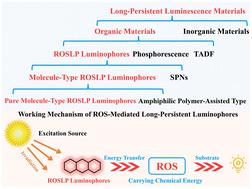当前位置:
X-MOL 学术
›
Chem. Soc. Rev.
›
论文详情
Our official English website, www.x-mol.net, welcomes your
feedback! (Note: you will need to create a separate account there.)
Reactive oxygen species-mediated organic long-persistent luminophores light up biomedicine: from two-component separated nano-systems to integrated uni-luminophores
Chemical Society Reviews ( IF 40.4 ) Pub Date : 2024-10-04 , DOI: 10.1039/d4cs00443d Zhe Li, Hongwen Liu, Xiao-Bing Zhang
Chemical Society Reviews ( IF 40.4 ) Pub Date : 2024-10-04 , DOI: 10.1039/d4cs00443d Zhe Li, Hongwen Liu, Xiao-Bing Zhang

|
Organic luminophores have been widely utilized in cells and in vivo fluorescence imaging but face extreme challenges, including a low signal-to-noise ratio (SNR) and even false signals, due to non-negligible background signals derived from real-time excitation lasers. To overcome these challenges, in the last decade, functionalized organic long-persistent luminophores have gained much attention. Such luminophores could not only overcome the biological toxicity of inorganic long-persistent luminescent materials (metabolic toxicity and leakage risk of inorganic heavy metals), but also continue to emit long-persistent luminescence after removing the excitation source, thus effectively improving imaging quality. More importantly, organic long-persistent luminophores have good structure tailorability for the construction of activable probes, which is favorable for biosensing. Recently, the development of reactive oxygen species (ROS)-mediated long-persistent (ROSLP) luminophores (especially organic small-molecule ROSLP luminophores) is still in the rising stage. Notably, ROSLP luminophores for in vivo imaging have experienced from two-component separated nano-systems to integrated uni-luminophores, which obtained gradually better designability and biocompatibility. In this review, we summarize the progress and challenges of organic long-persistent luminophores, focusing on their development history, long-persistent luminescence working mechanisms, and biomedical applications. We hope that these insights will help scientists further develop functionalized organic long-persistent luminophores for the biomedical field.
中文翻译:

活性氧介导的有机长持久性发光团照亮生物医学:从双组分分离的纳米系统到集成的单发光团
有机发光团已广泛用于细胞和体内荧光成像,但由于实时激发激光器产生的背景信号不可忽略,因此面临极端挑战,包括低信噪比 (SNR) 甚至错误信号。为了克服这些挑战,在过去十年中,功能化的有机长持久性发光团受到广泛关注。这种发光团不仅可以克服无机长持久性发光材料的生物毒性(无机重金属的代谢毒性和泄漏风险),而且在去除激发源后仍能继续发出长持久性发光,从而有效提高成像质量。更重要的是,有机长持久性发光团具有良好的结构定制性,适合构建可激活探针,有利于生物传感。近年来,活性氧 (ROS) 介导的长持久性 (ROSLP) 发光团(尤其是有机小分子 ROSLP 发光团)的发展仍处于上升阶段。值得注意的是,用于体内成像的 ROSLP 发光团经历了从双组分分离的纳米系统到集成的单发光团,逐渐获得了更好的可设计性和生物相容性。本文总结了有机长持续发光团的研究进展和挑战,重点介绍了其发展历史、长持续发光工作机制和生物医学应用。我们希望这些见解将帮助科学家进一步为生物医学领域开发功能化有机长持久性发光团。
更新日期:2024-10-04
中文翻译:

活性氧介导的有机长持久性发光团照亮生物医学:从双组分分离的纳米系统到集成的单发光团
有机发光团已广泛用于细胞和体内荧光成像,但由于实时激发激光器产生的背景信号不可忽略,因此面临极端挑战,包括低信噪比 (SNR) 甚至错误信号。为了克服这些挑战,在过去十年中,功能化的有机长持久性发光团受到广泛关注。这种发光团不仅可以克服无机长持久性发光材料的生物毒性(无机重金属的代谢毒性和泄漏风险),而且在去除激发源后仍能继续发出长持久性发光,从而有效提高成像质量。更重要的是,有机长持久性发光团具有良好的结构定制性,适合构建可激活探针,有利于生物传感。近年来,活性氧 (ROS) 介导的长持久性 (ROSLP) 发光团(尤其是有机小分子 ROSLP 发光团)的发展仍处于上升阶段。值得注意的是,用于体内成像的 ROSLP 发光团经历了从双组分分离的纳米系统到集成的单发光团,逐渐获得了更好的可设计性和生物相容性。本文总结了有机长持续发光团的研究进展和挑战,重点介绍了其发展历史、长持续发光工作机制和生物医学应用。我们希望这些见解将帮助科学家进一步为生物医学领域开发功能化有机长持久性发光团。


















































 京公网安备 11010802027423号
京公网安备 11010802027423号